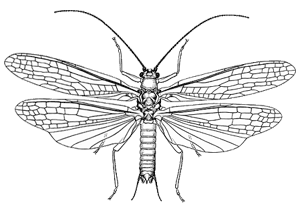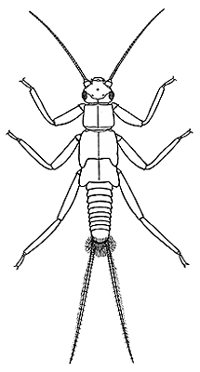|
Plecoptera:
stoneflies
Characteristics
Stoneflies
are soft-bodied insects that can grow up to 50 millimetres long
with a wingspan of 100 millimetres. Adult stoneflies are always
found near freshwater as they have aquatic larvae
and as adults they are not powerful fliers. They therefore have
poor dispersal capabilities are rarely move far from the place they
were born. Stoneflies are recognisable by the following characteristics:

Trinotoperla
species
|
|
- Elongated,
flattened, soft body
- 2 pairs of
membranous
wings that are held curved around the body at rest. Some species
are wingless while others have reduced wings
- Hind wings
slightly wider than forewings
- 2 cerci
at tip of abdomen
The larvae
of stoneflies are aquatic and appear similar to the adults but lack
wings. Larvae
also possess external gills along the edge of their abdomens
and at the tip.
|

Trinotoperla species larvae
|
Trinotoperla
species belong to the GRIPOPTERYGIDAE family of stoneflies which
consists of mostly dull-coloured insects ranging from very small
to large in size. Trinotoperla species are commonly large,
with a wing span of more than 30 millimetres. Most are uniformly
dull-coloured with a slight darkening at the base of the wings.
Adults are found throughout the summer months, although some of
the smaller species of GRIPOPTERYGIDAE are more common during spring.
The larvae
of this family have an obvious tuft or rosette of filiform
anal gills which can range from white through to pink or pale mauve
in colour. The larvae
can be found clinging to the underside of rocks and other debris
in fast flowing water.
Life Cycle
Adult
stoneflies live and mate near water, as their larvae
are fully aquatic. Female stoneflies lay their eggs on the water
as they fly slowly over it, or let them drop freely to the water
while resting on overhanging rocks or logs. Approximately 100 to
1000 eggs may by laid and development of the larvae
is slow, taking from 1-3 years. Depending on the species, stonefly
larvae
can moult
up to 15 times before reaching maturity.
Feeding
Adult
stoneflies are herbivorous
and usually feed on algae, lichens, rotting wood or other detritus.
The larvae
are mostly herbivorous
also and feed on a wide variety of small plants, algae or dead plant
matter, although some species are carnivorous.
Habitat
Stoneflies
prefer freshwater habitats and their surrounds, and adults can be
found resting during the day on tree trunks alongside streams and
lakes. The larvae
are aquatic and can sometimes be found among the gravel on the bottom
of fast flowing streams and well aerated lakes.
|


